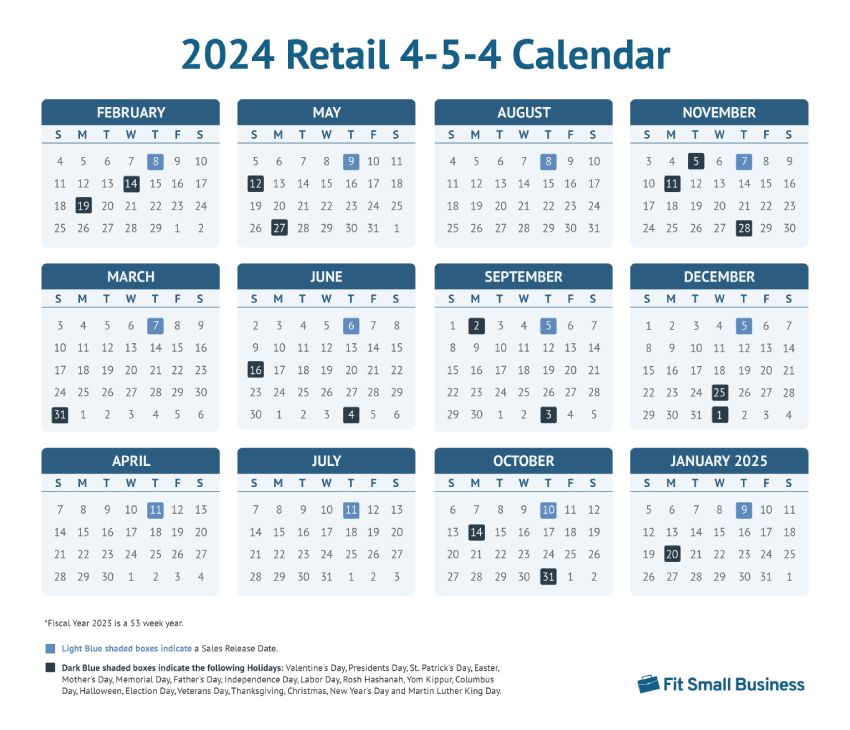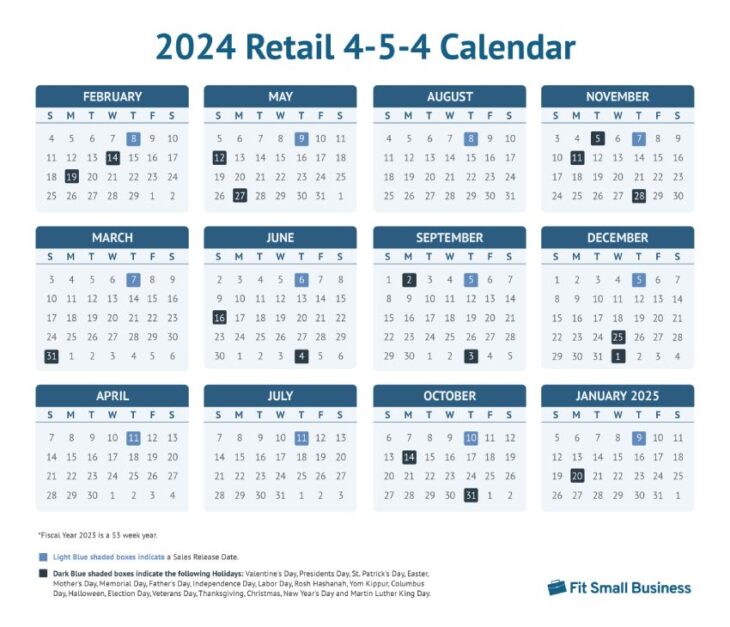Decoding The Retail 4-5-4 Calendar: Optimizing Stock And Gross sales By Strategic Planning
Decoding the Retail 4-5-4 Calendar: Optimizing Stock and Gross sales By Strategic Planning
Associated Articles: Decoding the Retail 4-5-4 Calendar: Optimizing Stock and Gross sales By Strategic Planning
Introduction
With enthusiasm, let’s navigate via the intriguing subject associated to Decoding the Retail 4-5-4 Calendar: Optimizing Stock and Gross sales By Strategic Planning. Let’s weave attention-grabbing info and provide recent views to the readers.
Desk of Content material
Decoding the Retail 4-5-4 Calendar: Optimizing Stock and Gross sales By Strategic Planning

The retail panorama is a fancy ecosystem, demanding meticulous planning and execution to thrive. One essential component usually missed by outsiders is the calendar – not simply any calendar, however the specialised 4-5-4 retail calendar. This distinctive scheduling system, with its seemingly arbitrary numerical construction, underpins a lot of the success of many main retailers, permitting them to optimize stock administration, predict gross sales tendencies, and in the end, maximize profitability. This text delves deep into the intricacies of the 4-5-4 calendar, explaining its mechanics, benefits, and the strategic concerns concerned in its implementation.
Understanding the 4-5-4 Construction:
Not like the usual 52-week Gregorian calendar, the 4-5-4 retail calendar divides the 12 months into 13 4-week intervals, interspersed with five-week intervals. This creates a rhythm of shorter and longer months, reflecting the cyclical nature of retail gross sales and client habits. The "4" weeks characterize shorter months, whereas the "5" weeks characterize longer months. This construction just isn’t arbitrary; it’s fastidiously designed to align with seasonal modifications, promotional cycles, and stock replenishment wants.
A typical 4-5-4 calendar may appear like this (although the particular association can range barely 12 months to 12 months):
- 4-week intervals: These are usually used for slower gross sales months or intervals requiring much less stock.
- 5-week intervals: These accommodate peak gross sales seasons, holidays, or intervals demanding larger stock ranges to satisfy elevated demand. This further week gives essential buffer for managing inventory and assembly buyer expectations.
Why Select a 4-5-4 Retail Calendar?
The advantages of adopting a 4-5-4 calendar are multifaceted and contribute considerably to improved retail operations:
-
Improved Stock Administration: The calendar’s construction permits retailers to higher anticipate and handle stock ranges all year long. By precisely forecasting demand primarily based on the size of every interval, companies can keep away from stockouts throughout peak seasons and reduce the danger of overstocking throughout slower intervals. This results in lowered warehousing prices, minimized waste from out of date stock, and improved money circulation.
-
Enhanced Gross sales Forecasting: The cyclical nature of the calendar helps retailers refine their gross sales forecasting fashions. Historic gross sales knowledge could be analyzed on a 4-5-4 foundation, figuring out tendencies and patterns extra successfully than with a typical calendar. This improved accuracy permits for extra exact budgeting, useful resource allocation, and promotional planning.
-
Optimized Planning and Scheduling: The calendar gives a transparent framework for planning advertising campaigns, promotional actions, and staffing ranges. Retailers can align their advertising efforts with the longer and shorter intervals, guaranteeing that sources are deployed successfully to maximise ROI. Equally, staffing wants could be adjusted to match anticipated demand, optimizing labor prices.
-
Simplified Monetary Reporting: The 4-5-4 calendar simplifies monetary reporting by offering a constant and comparable framework for analyzing efficiency throughout intervals. This facilitates simpler identification of tendencies, anomalies, and areas for enchancment. Evaluating efficiency throughout similar-length intervals is way simpler than evaluating a four-week interval to a five-week one utilizing a typical calendar.
-
Higher Alignment with Shopper Conduct: The calendar implicitly acknowledges the fluctuations in client spending all year long. By recognizing and accommodating these fluctuations, retailers can higher tailor their choices and methods to satisfy buyer wants and expectations.
Implementing the 4-5-4 Calendar:
Implementing a 4-5-4 calendar requires cautious planning and coordination throughout varied departments inside a retail group. Key steps embrace:
-
Knowledge Evaluation: Thorough evaluation of historic gross sales knowledge is essential to find out the optimum allocation of 4-week and 5-week intervals. This entails figuring out peak and off-peak seasons, and understanding the connection between gross sales quantity and stock ranges.
-
System Integration: The calendar must be built-in into all related techniques, together with stock administration software program, point-of-sale techniques, and monetary reporting instruments. This ensures seamless knowledge circulation and correct reporting.
-
Coaching and Communication: All related employees, from stock managers to advertising groups and gross sales associates, should be adequately skilled on the use and implications of the 4-5-4 calendar. Clear communication is crucial to make sure everybody understands and adheres to the brand new system.
-
Steady Monitoring and Adjustment: The 4-5-4 calendar just isn’t a static system. It requires steady monitoring and changes primarily based on precise gross sales knowledge and market tendencies. Common opinions and modifications are essential to make sure the calendar stays efficient and related.
Challenges and Concerns:
Whereas the 4-5-4 calendar provides vital benefits, it additionally presents some challenges:
-
Complexity: The shift from a typical calendar can initially be complicated for employees unfamiliar with the system. Efficient coaching and communication are important to mitigate this.
-
Knowledge Migration: Migrating knowledge from a typical calendar to a 4-5-4 system is usually a complicated and time-consuming course of. Cautious planning and execution are very important to make sure knowledge integrity.
-
Accounting Changes: Accounting procedures may have changes to accommodate the various lengths of intervals. This requires shut collaboration between the retail operations and finance departments.
Past the Fundamentals: Superior Functions:
The 4-5-4 calendar just isn’t merely a scheduling device; it’s a strategic asset that may be leveraged for superior planning and evaluation. For instance:
-
Promotional Marketing campaign Optimization: Retailers can strategically schedule promotions to coincide with the longer 5-week intervals, maximizing their influence throughout peak procuring seasons.
-
Provide Chain Administration: The calendar can be utilized to optimize provide chain operations, guaranteeing well timed supply of products to satisfy anticipated demand.
-
Pricing Methods: Retailers can regulate pricing methods primarily based on the size of every interval, considering components comparable to stock ranges and client habits.
Conclusion:
The 4-5-4 retail calendar is a robust device for optimizing retail operations. By offering a framework for improved stock administration, gross sales forecasting, and useful resource allocation, it permits retailers to reinforce profitability and acquire a aggressive edge. Whereas implementing the system requires cautious planning and execution, the long-term advantages far outweigh the preliminary challenges. By embracing this strategic method to calendar administration, retailers can transfer past reactive decision-making and embrace a extra proactive, data-driven method to operating their companies. The 4-5-4 calendar is not only a calendar; it is a roadmap to retail success.








Closure
Thus, we hope this text has offered precious insights into Decoding the Retail 4-5-4 Calendar: Optimizing Stock and Gross sales By Strategic Planning. We thanks for taking the time to learn this text. See you in our subsequent article!
Leave a Reply